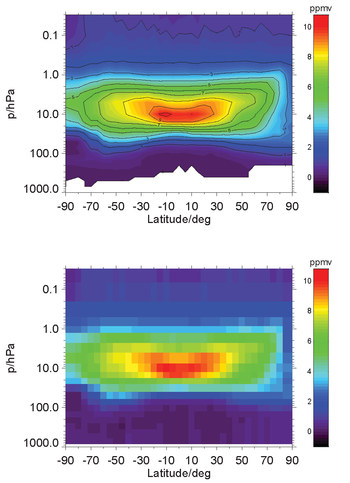No more trouble with averaging kernels!

The top panel shows an ozone distribution measured with MIPAS, using the regular retrieval setup. In the lower panel a representation of these data is shown which is free of formal prior information. This is achieved by using an altitude grid coarse enough. The advantage is that the data user does not have to care about averaging kernels any longer.
An optimized altitude grid is chosen that is as fine as possible but coarse enough to allow a retrieval without formal constraint. This user-friendly representation of the data will be made available in addition to the regular data product. In this representation, the data will be provided on a fixed pressure grid coarse enough to allow a virtually unconstrained retrieval. As to avoid data interpolation, the grid is chosen to be a subset of the pressure grids used by the Chemistry Climate Model Initiative and the Data Initiative within the Stratosphere-troposphere Processes And their Role in Climate (SPARC) project as well as the Intergovernmental Panel of Climate Change climatologies and model calculations. For representation, the profiles have been transformed to boxcar base functions, which means that volume mixing ratios are constant within a layer. This representation is thought to be more adequate for comparison with model data. While this method is applicable also to vertical profiles of other species, the method is discussed using ozone as an example.
For further details, see: http://www.atmos-meas-tech.net/8/2749/2015/amt-8-2749-2015.pdf
